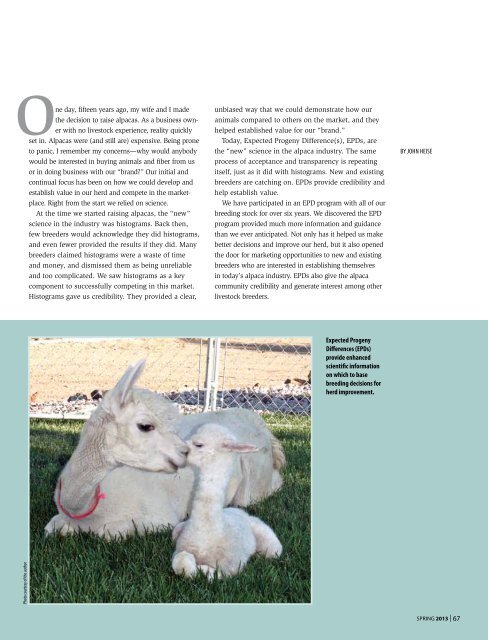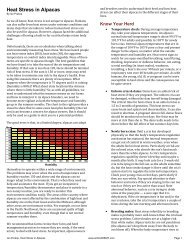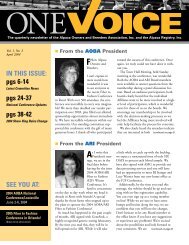download this article as PDF - ariLIST
download this article as PDF - ariLIST
download this article as PDF - ariLIST
Create successful ePaper yourself
Turn your PDF publications into a flip-book with our unique Google optimized e-Paper software.
O<br />
ne day, fifteen years ago, my wife and I made<br />
the decision to raise alpac<strong>as</strong>. As a business owner<br />
with no livestock experience, reality quickly<br />
set in. Alpac<strong>as</strong> were (and still are) expensive. Being prone<br />
to panic, I remember my concerns—why would anybody<br />
would be interested in buying animals and fiber from us<br />
or in doing business with our “brand?” Our initial and<br />
continual focus h<strong>as</strong> been on how we could develop and<br />
establish value in our herd and compete in the marketplace.<br />
Right from the start we relied on science.<br />
At the time we started raising alpac<strong>as</strong>, the “new”<br />
science in the industry w<strong>as</strong> histograms. Back then,<br />
few breeders would acknowledge they did histograms,<br />
and even fewer provided the results if they did. Many<br />
breeders claimed histograms were a w<strong>as</strong>te of time<br />
and money, and dismissed them <strong>as</strong> being unreliable<br />
and too complicated. We saw histograms <strong>as</strong> a key<br />
component to successfully competing in <strong>this</strong> market.<br />
Histograms gave us credibility. They provided a clear,<br />
unbi<strong>as</strong>ed way that we could demonstrate how our<br />
animals compared to others on the market, and they<br />
helped established value for our “brand.”<br />
Today, Expected Progeny Difference(s), EPDs, are<br />
the “new” science in the alpaca industry. The same<br />
process of acceptance and transparency is repeating<br />
itself, just <strong>as</strong> it did with histograms. New and existing<br />
breeders are catching on. EPDs provide credibility and<br />
help establish value.<br />
We have participated in an EPD program with all of our<br />
breeding stock for over six years. We discovered the EPD<br />
program provided much more information and guidance<br />
than we ever anticipated. Not only h<strong>as</strong> it helped us make<br />
better decisions and improve our herd, but it also opened<br />
the door for marketing opportunities to new and existing<br />
breeders who are interested in establishing themselves<br />
in today’s alpaca industry. EPDs also give the alpaca<br />
community credibility and generate interest among other<br />
livestock breeders.<br />
By John Heise<br />
Expected Progeny<br />
Differences (EPDs)<br />
provide enhanced<br />
scientific information<br />
on which to b<strong>as</strong>e<br />
breeding decisions for<br />
herd improvement.<br />
Photo courtesy of the author<br />
spring 2013 | 67





